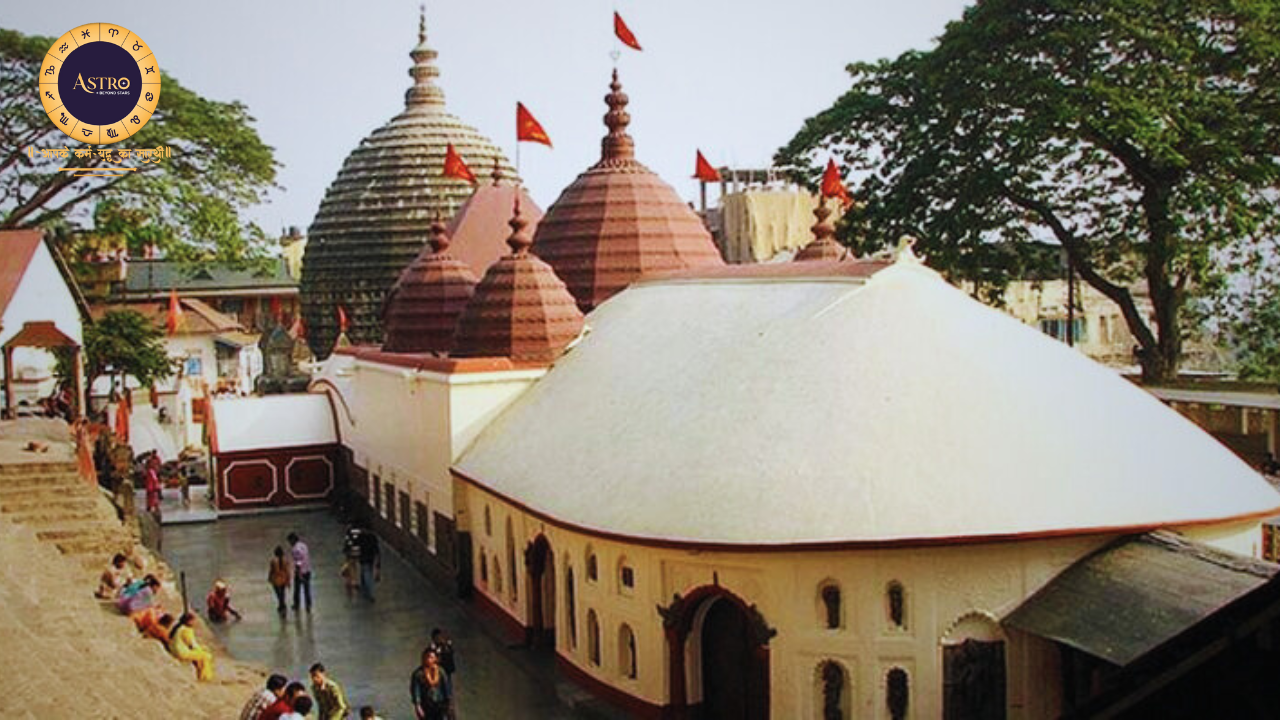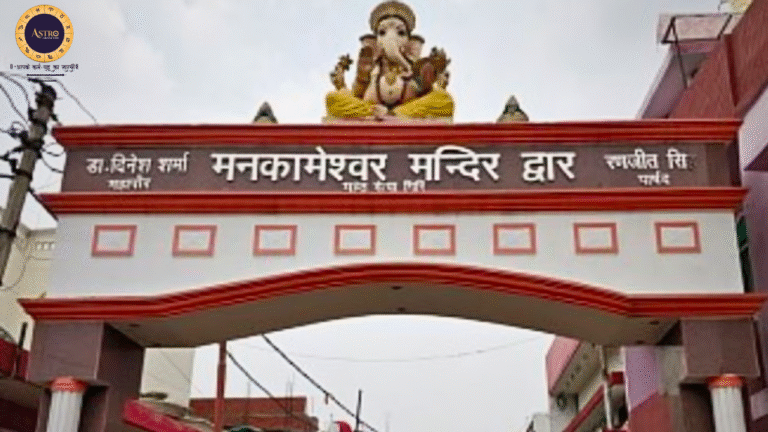The Kamakhya Temple is one of the most revered Shakti Peethas in India, located atop the Nilachal Hill in Guwahati, Assam. The temple is dedicated to Goddess Kamakhya, an incarnation of Shakti, and is associated with powerful Tantric traditions.
The Mythology & Legend
Kamakhya Temple is linked to the Daksha Yagna and Sati’s sacrifice. According to Hindu mythology, when Sati self-immolated in grief over her father Daksha’s insult to Shiva, the enraged Shiva carried her corpse and performed the Tandava (cosmic dance of destruction). To pacify him, Lord Vishnu dismembered Sati’s body using his Sudarshana Chakra. The body parts fell at different places across the Indian subcontinent, which later became the Shakti Peethas.
The Kamakhya Temple marks the spot where Sati’s yoni (womb and genital organ) is believed to have fallen, making it a symbol of fertility and divine feminine energy.
Unique Features & Rituals
1. Absence of an Idol: Unlike most Hindu temples, Kamakhya doesn’t have a statue or an image of the goddess. Instead, worship is performed at a naturally formed rock fissure that is perpetually moist, symbolizing the yoni.
2. Ambubachi Mela: This annual festival, celebrated in June, marks the menstruation of the goddess. It is believed that the subterranean water turns red during this time, signifying the goddess’s fertility. The temple remains closed for three days, after which devotees are allowed inside.
3. A Center of Tantra: The temple is one of the most prominent seats of Tantric practices in India. Many sadhaks (Tantric practitioners) visit to seek spiritual enlightenment and mystical powers.
4. Mystical Powers & Miracles: It is believed that the Kamakhya Temple fulfills desires, and many devotees perform special rituals for fertility, wealth, and spiritual growth.
Architectural Significance
The temple showcases a blend of Kamarupa and medieval temple architecture. The dome-shaped shikhara is unique and represents the fusion of Hindu and tribal artistic styles.
The legend
The well-known legend of Daksha Yajna, and the origin of the Shakti Peethas, including Kamakhya Temple.
The Story of Daksha Yajna & Sati’s Sacrifice
· Sati, the daughter of King Daksha, was deeply devoted to Shiva and married him against her father’s wishes.
· Daksha held animosity toward Shiva, considering him an ascetic, unworthy of his daughter.
· To insult Shiva, Daksha organized a grand yajna (sacrificial ritual) but deliberately did not invite Shiva and Sati.
· Sati, despite Shiva’s warnings, attended the yajna but was humiliated when her father openly insulted Shiva in front of all deities.
· Overcome with grief and rage, Sati self-immolated in the fire of the yajna using her own yogic powers.
· When Shiva learned of this, he was overcome with sorrow and fury. From his locks, he created Virabhadra, a fierce warrior who stormed the yajna and beheaded Daksha.
The Birth of Shakti Peethas
· Consumed by grief, Shiva carried Sati’s lifeless body and roamed across the universe, performing the Tandava, the cosmic dance of destruction.
· To prevent the devastation of the cosmos, Vishnu used his Sudarshan Chakra to cut Sati’s body into pieces.
· Each piece fell at different locations across the Indian subcontinent, becoming sacred sites known as Shakti Peethas, where the goddess is worshiped in different forms.
The Temple Complex and Its Tantric Significance
The Kamakhya Temple is not just one shrine but a complex of temples, each dedicated to the ten Mahavidyas, the ten aspects of the Divine Mother in Tantric tradition. These include:
1. Kali – The fierce destroyer of evil.
2. Tara – The compassionate guide.
3. Sodashi (Tripura Sundari) – The beauty of the three worlds.
4. Bhuvaneshwari – The queen of the universe.
5. Bhairavi – The warrior goddess.
6. Chhinnamasta – The self-decapitated goddess, symbolizing self-sacrifice.
7. Dhumavati – The widow goddess, representing detachment.
8. Bagulamukhi – The goddess of hypnosis and speech control.
9. Matangi – The outcast goddess of wisdom and art.
10. Kamala – The goddess of wealth and prosperity.
This makes Kamakhya Temple a significant center for Tantric practices, where seekers come for spiritual enlightenment, siddhis (mystical powers), and esoteric rituals.
Historical Background of Kamakhya Temple
· The original Kamakhya Temple was destroyed during a Muslim invasion in the early 16th century.
· King Naranarayana of Cooch Behar rebuilt the temple in 1565 CE, restoring its grandeur and giving it its current medieval Hindu temple architecture.
· The main temple dome is built in the style of a beehive, unique to the region.
Ancient Assam and the Legend of Naraka
· Before the 5th century CE, Assam was known as Pragjyotishapura, meaning the “City of Eastern Astrology.”
· Naraka, an adventurer from Mithila, established the kingdom of Kamarupa and declared himself as the protector of the Yoni-Goddess Kamakhya.
· It is believed that he renamed Pragjyotishapura to Kamarupa, inspired by the goddess’s name.
· The name Kamarupa itself means “the form of desire,” aligning with the goddess’s association with love, fertility, and creation.
Why Kamakhya Temple is Unique
· It is one of the most sacred Shakti Peethas.
· It is deeply connected to Tantra, mysticism, and esoteric rituals.
· The temple complex houses the ten Mahavidya goddesses, each representing different aspects of Shakti.
· It has a rich historical and mythological past, spanning from the ancient kingdom of Kamarupa to its reconstruction by Naranarayana.
Kamakhya Temple – The Symbol of Divine Feminine Energy
· The Kamakhya Temple is believed to be the site where Sati’s yoni (womb) fell.
· This makes it one of the most powerful and revered Shakti Peethas, symbolizing the goddess’s fertility, power, and creative force.
· The temple is a major center for Tantric worship, and its rituals celebrate the union of Shiva and Shakti.
The Kamakhya Temple is deeply associated with the divine feminine energy and menstruation, which is celebrated as a symbol of fertility, creation, and power.
The ‘Bleeding Goddess’ and Ambubachi Mela
· Kamakhya Devi, also called the Bleeding Goddess, represents the creative force of nature.
· The temple’s sanctum sanctorum (Garbhagriha) does not have an idol but contains a rock fissure, which is worshiped as the yoni (womb) of the goddess.
· Every year, during the Ambubachi Mela in June, it is believed that the goddess undergoes her annual menstruation cycle.
· During this time, the Brahmaputra River near the temple supposedly turns red, leading to speculation and mystery around the phenomenon.
· The temple remains closed for three days, symbolizing the period of rest, after which the goddess is bathed, and the temple is reopened.
The Significance of Menstruation in Shakti Worship
· Menstruation is considered a divine process in Shaktism, representing a woman’s ability to create life.
· Unlike many traditions that view menstruation as impure, the Kamakhya Temple celebrates it as sacred.
· The festival promotes reverence for women and their natural bodily cycles, reinforcing the belief that the power of creation lies within the feminine divine (Shakti).
The Mystery of the Red Brahmaputra Water
· There is no scientific evidence proving that the Brahmaputra River turns red due to divine menstruation.
· Some believe the red colour may come from natural iron-rich deposits or vermillion offerings.
· However, for devotees, the symbolic significance is more important than scientific explanations.
Why Kamakhya is Unique
· It is one of the few temples that openly acknowledges and worships menstruation as divine.
· It stands as a powerful symbol of feminine energy, creation, and the acceptance of natural cycles.
The Kamakhya Temple is one of the most mystical and powerful Shakti Peethas in India. Unlike most Hindu temples, Kamakhya Devi’s shrine is deeply connected to feminine energy, Tantra, and esoteric traditions. Many sadhakas (spiritual seekers) visit Kamakhya for esoteric rituals, meditation, and attaining mystical powers (siddhis). The name Kamakhya means ‘She Who Grants Desires’ and devotees believe that prayers here bring love, marriage, and prosperity.
Goddess Kamakhya is the goddess of fertility, creation, and desire. She is the only deity worshiped in the form of a rock fissure (yoni) instead of an idol. Her temple celebrates menstruation, which is often considered taboo elsewhere. She is the center of Tantric traditions and secret esoteric rituals. She is one of the most powerful Shakti Peethas, fulfilling devotees’ desires.




